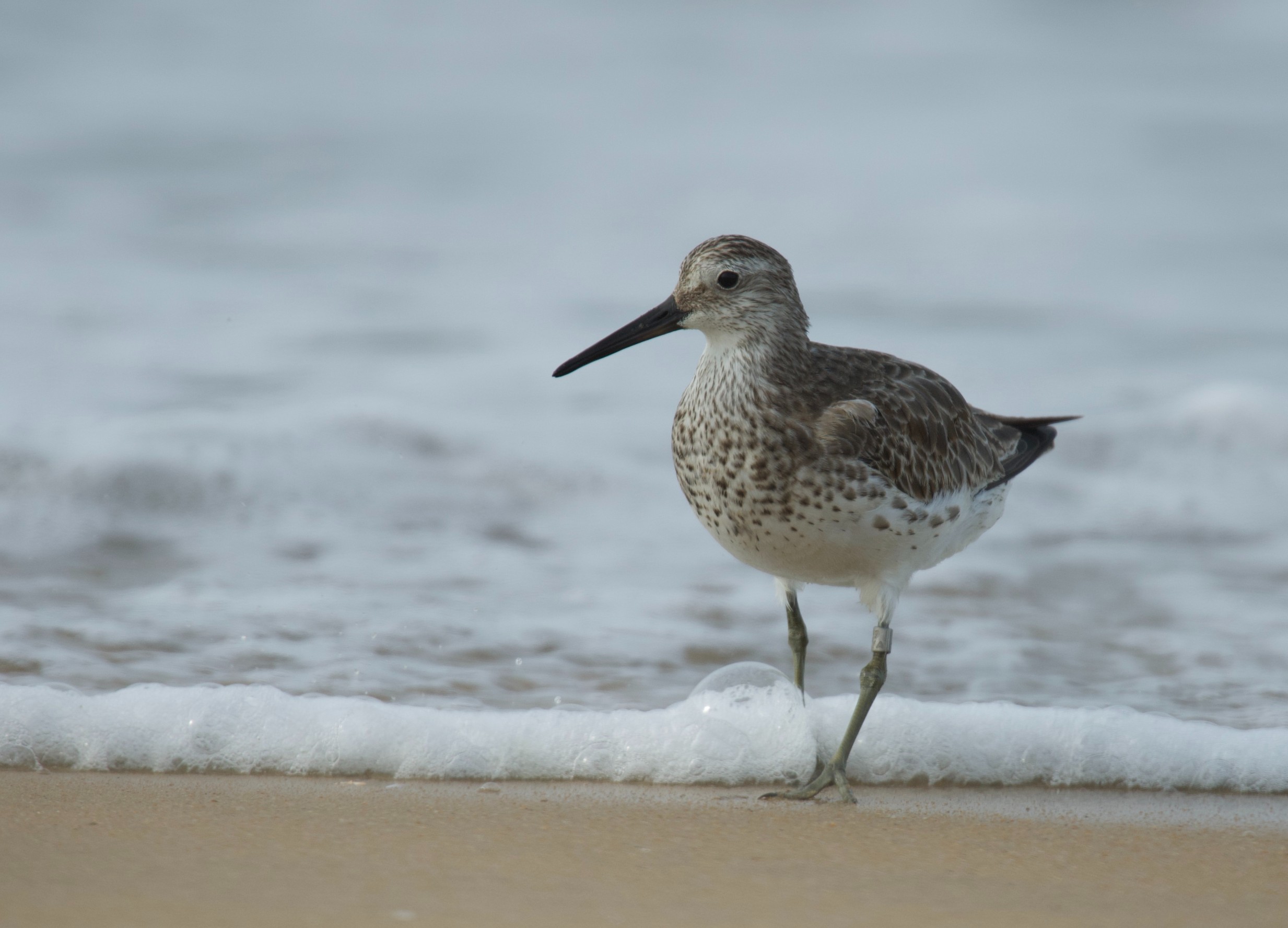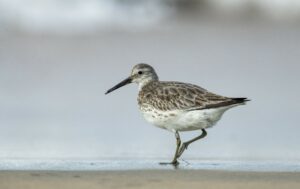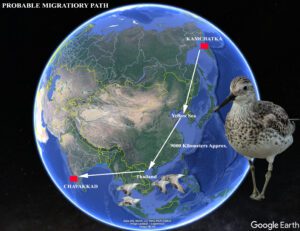The wader — or shorebird — spotted at Chavakkad in Thrissur was tagged and it helped three ornithologists in finding its migratory route.

The great knot, a migratory small wader bird, was tagged at the at the Khairusova-Belogolovaya estuary on the western coast of Russia's Kamchatka peninsula on 12 August. It was spotted in Chavakkad on 15 November. (Dr Kalesh Sadasivan)
The sun beats down mercilessly on the western parts of Kerala even in winter. The day temperature remains high, and humidity adds to the discomfort.
The weather was, however, kind on 15 November. The overcast sky provided some cover from the sun as three ornithologists spent half a day clicking photographs of a ring on a bird’s leg to decipher its inscription.
They clicked numerous photographs from all possible angles. The slow, painstaking process went on for hours, even as the temperature neared the 30 degrees Celsius-mark.
The men were careful not to scare away the rarely-sighted bird or its flock of about a dozen. Hundreds of other birds were in the immediate vicinity.
Hours later, their persistence paid off. The inscription became clear to them.
The engraving, “TC 32469 MOSKVA”, held the key to tracing the origin of the flock of great knots — waders or shorebirds — and their flight path to Chavakkad, a suburban coastal town in Thrissur, Kerala’s cultural capital.
Great knot sightings are rare in Kerala. The birders knew they are marked “endangered” in The International Union for Conservation of Nature (IUCN)’s Red Data Book, generally known as the Red List.

Great knots are endangered species, included in IUCN’s Red List. The ring is visible on its left leg. (Dr Kalesh Sadasivan)
Ornithologists Dr Kalesh Sadasivan, PP Sreenivasan and Samkumar PB were looking for Caspian plovers, also a wader, on the beach when they came across a dozen great knots. Though Kerala has previously received great knots, they are rarely seen in such large numbers at one location.
While observing the birds, Thrissur-based Sreenivasan noticed a ring on the leg of one bird and drew the attention of others to the tag. And then the prolonged photo shoot began.
“Sighting the ring was elating… but once we saw it we decided to document the number engraved on the ring,” Sreenivasan, a veteran birder, said.
“There were over a hundred other birds near it. Targeting a single bird was a challenge. We spent half a day in the sun, trying to make sense of the inscription on the ring. After clicking the ring from several angles, we understood the inscription,” Sadasivan said.
Armed with the “keyword”, the ornithologists launched a probe. They knew “MOSKVA” referred to the river by which Moscow was built.
“The word MOSKVA gave us the first clue that it was a Russian ring,” Samkumar said. He is a member of Birders sans Borders, a Thrissur-based non-profit organisation working for the conservation of birds.
“Once the Russian connection was confirmed, we contacted Dmitry Dorofeev, who was in charge of the bird ringing operations at Kamchatka peninsula, where these birds are known to roost,” Sadasivan, a research associate at the Travancore History Society in Thiruvananthapuram, said.
“The final confirmation came via email,” he added.
Dorofeev informed them that the bird was tagged with the ring at the Khairusova-Belogolovaya estuary on the western coast of the Kamchatka peninsula in the Russian Far East.
Freezing arctic winds from Siberia combined with the cold Oyashio sea current keep the peninsula covered in snow from October to late May.
According to the Ust’-Kamchastsk weather station, the minimum and maximum temperatures at Kamchatka on 15 November were minus 3 degrees and two degrees Celsius, respectively.
Dorofeev also told them that the juvenile bird was tagged on 12 August. The temperatures then were 10 and 16 degrees Celsius, respectively.
The Russian expert on endangered species also shed light on the possible pathway of the migratory small waders.
They normally stay in the Yellow Sea region and Thailand in Southeast Asia en route to their southern winter grounds, including the Indian peninsula.
“This means that this bird has travelled more than 9,000 km to reach the eastern coast of Kerala,” he said in the email.

The probable flight path of great knots from Kamchatka in the Russian Far East to Chavakkad in Kerala. (Supplied)
Dorofeev had tagged around 1,000 great knots — but, till now, only two have been resighted in India. A few months ago, another great knot with the tag number 6Z was sighted at Jamnagar in Gujarat.
“The birds use the Central Asian Flyway, which is considered an important international migration pathway to reach the southern regions of Asia,” the birders quoted Dorofeev as saying.
Sadasivan said there was an increase in the migratory birds visiting Kerala and the Chavakkad beach is one of the favourite winter sojourns. He felt that the construction activities on the South China Sea coast were rerouting the birds to regions further south.
“Great knots eat insects. The Chavakkad beach is rich with such insects and hence it becomes a favourite destination for birds. They usually stay near estuaries. Perhaps, the low pollution level, too, is attracting them to Chavakkad,” he said.
Sadasivan added that although places such as Kadalundy in Kozhikode have “community reserve” status, Chavakkad beach is yet to get such a tag. “It is important to have the status to protect the migratory birds coming to the area,” he said.
For the record, Kamchatka was shivering at minus 4 degrees Celsius at 3.45 pm on Friday, 2 December. Kamchatka is 6.30 hours ahead of the Indian Standard Time (IST).

Jul 26, 2024

Jul 26, 2024

Jul 26, 2024

Jul 25, 2024

Jul 25, 2024

Jul 25, 2024